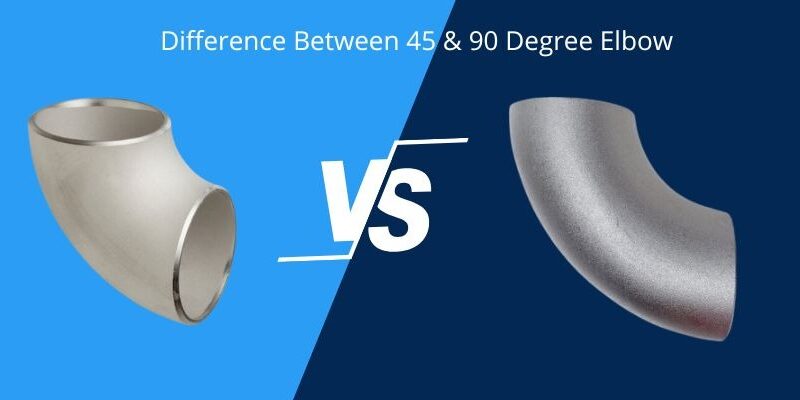Choosing Between 45-Degree & 90-Degree Elbows: A Comprehensive Guide
When it comes to piping systems, every component plays a crucial role in ensuring optimal flow and functionality. Among these are pipe elbows, key fittings used to change the direction of flow in a pipeline. Two of the most commonly used elbows are the 45-degree elbow and the 90-degree elbow. While they may appear similar at first glance, their specific applications differ significantly.
What is a Pipe Elbow?
A pipe elbow is a fitting used in piping systems to redirect the flow of liquid, gas, or other materials. These fittings are essential in various industries, such as plumbing, HVAC, oil and gas, and manufacturing. By redirecting flow, pipe elbows help improve the layout and functionality of the system while preventing unnecessary pressure buildup.
Pipe elbows come in various angles, materials, and sizes, but the two most frequently used are the 45-degree and 90-degree elbows. Each is designed for distinct applications, which we’ll explore below.
What is a 45-Degree Elbow Used For?
A 45-degree elbow is designed to provide a moderate change in direction within a piping system. Its curved structure delivers a gradual shift in flow, resulting in reduced resistance and less pressure drop. But what is a 45-degree elbow used for?
- Smooth Fluid Flow: This design makes the 45-degree elbow ideal for situations where uninterrupted, smooth flow is essential, such as in water pipelines and drainage systems.
- Custom System Layouts: When a piping layout requires a gentle turn, a 45-degree elbow is preferred to avoid sharp directional shifts. This prevents damage to pipelines from sudden changes in flow pressure.
- Ventilation Systems: It is often used in ventilation and exhaust systems to ensure airflow isn’t disrupted.
- Agricultural Settings: These elbows are also seen in irrigation systems where smooth directional changes are vital for water distribution.
What is a 90-Degree Elbow Used For?
The 90-degree elbow is designed for more drastic directional changes, making it one of the most commonly used fittings.
- Tight Space Configurations: This style of elbow is perfect for areas where space is constrained. It allows for a right-angle turn in the pipeline.
- Plumbing Systems: Widely used in household and commercial plumbing, a 90-degree elbow helps route pipes around walls, corners, and fixtures with ease.
- Industrial Applications: It is a common fixture in industrial settings where pipelines need to connect at sharp angles, such as in oil and gas refineries.
- Waste Systems: 90-degree elbows are often used in waste piping to direct sewage and wastewater effectively.
- HVAC Systems: When ducts need sharp directional changes to fit into tight spaces, this elbow is the go-to fitting.
Compared to the 45-degree elbow or 90-degree elbow creates a more abrupt change in flow direction. While this can slightly increase pressure loss, it’s usually not a concern for most applications where sharper turns are necessary.
Key Differences Between 45-Degree and 90-Degree Elbows
To better understand which elbow is right for your project, it’s helpful to compare their main features.
| Category | 45-Degree Elbow | 90-Degree Elbow |
|---|---|---|
| Angle of Turn | Provides a smooth 45-degree angle turn. | Creates a sharp 90-degree right-angle turn. |
| Pressure Loss | Minimal pressure drop due to gradual turn. | Slightly higher pressure loss. |
| Applications | Best for pipelines requiring smooth flow. | Ideal for compact layouts and sharp turns. |
| Common Industries | Water systems, irrigation, HVAC, ventilation. | Plumbing, industrial, HVAC, waste systems. |
| Space Requirements | Requires more room for alignment. | Fits into tight spaces. |
Factors to Consider When Choosing Between 45-Degree and 90-Degree Elbows
Selecting the right elbow requires careful consideration of your project’s needs. Keep these factors in mind:
- System Layout: Consider whether the piping needs sharp directional changes or smoother curves. For sharp turns, use a 90-degree elbow; for gradual transitions, opt for a 45-degree elbow.
- Flow Efficiency: If maintaining smooth flow is critical, the 45-degree elbow is the better choice, as it reduces resistance and energy loss.
- Available Space: For compact installations, the 90-degree elbow is ideal, fitting easily into confined areas.
- Material Compatibility: Ensure the elbow material matches the pipe material to avoid corrosion and leaks.
- Pressure Tolerance: Evaluate the pressure requirements of your system. Both elbows can handle high pressure, but pressure drops may vary with the angle.
- Cost Considerations: Depending on the type, size, and material, costs can differ. Factor this into your budget calculations.
Final Thoughts
Choosing between 45-degree and 90-degree elbows is a crucial decision when planning or modifying a piping system. While the 45-degree elbow ensures smoother flow with less resistance, the 90-degree elbow is perfect for making compact, sharp turns. Companies like Neo Impex Stainless Pvt. Ltd. provide high-quality elbows to meet diverse industry needs. Understanding what a 45-degree elbow is used for and what a 90-degree elbow is used for helps ensure you select the right fitting based on your project’s requirements.




